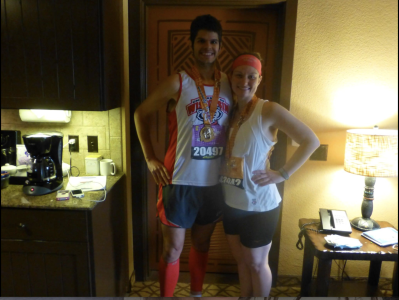2023 Fall/Winter & 2024 Spring Training Plans - Canova - Disneyland 5k/10k/HM & Non-Cancelled M
The end of the 2023 summer training plan with LIIFT4, LIIFT More, and all easy running at a lower volume brings the beginning of the next training plan. With the summer temps hopefully/mostly in the past, it's time to bring back the running volume and get ready to attack some new races. So let's dive in to what I've come up with.
Pacing
So the place I like to start when developing a training plan is the pacing of the plan. I'm an advocate to use recent races to determine current fitness, and then use that information to setup training paces. The last few training plans I've been using my 2019 HM in 1:28:40, 2020 Mile in 5:42, and 2020 M in 3:15:13. But to be fair and honest, I'm probably not there anymore for one reason or another. So I'm using my 2023 Spring season as the basis for determining pacing. I ran a 42:42 10k and 1:32:25 HM. The HM is the better of the two and translates to a 7:20 marathon training pace (3:12:35, not that I think that's a realistic goal at the moment). So I plugged the 7:20 pace into the Canova training pace formula and got the following:
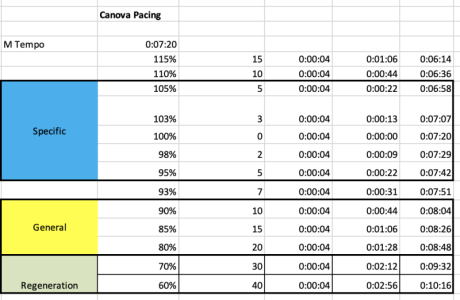
The formula is:
M Tempo pace + or - ((M Tempo pace/100) * (% Pace - 100))
Goal Races
I'm tentatively planning for the following:
11/12/23 - Madison HM
12/3/23 - Last Call HM
1/12-14/24 - Disneyland 5k, 10k, HM
4/27/24 - Non-Cancelled M
5/4/24 - Wisconsin M (back up race)
The training plan is 35 weeks long. That's longer than I usually write training plans for, but in reality it's two separate training plans. But the second plan builds off the first, so it was necessary to write both at the same time so that I could weave the two plans together cohesively. We'll cover the ins and outs of that later in this summary.
Strength Training
I plan to continue to use the LIIFT More program with alterations. I'll only do the strength training on the weekends when I have more time. I won't do the Legs workouts, and I won't do the HIIT portion of the workouts. I will continue to do the burn-outs and the core. Because of how the weeks play out, I'll start LIIFT More and then restart it before I finish at Week 28 to go because then it ends on time. This will give me about 1:20 hrs of strength training per week.
Run Training
So the training plan starts this week (8/28/23). Since my running volume has been about 3.5-4 hrs per week and 22-26 miles per week, I'm taking a few weeks to ease back into my normal training volume. I'm reinitiating running six days per week with two strength days on the weekend. I'm going to hold at about an hour per day for the first four weeks. At the start, I'll stay at the 80-85% M Tempo area. I've got 35 miles scheduled for the first week. I've got my second of three head surgeries to remove some pilar cysts from my scalp so I'm forbidden from running for 24 hrs after the procedure.
After two weeks of solely easy running, then I'll reintroduce some strides. Aiming for 4-6 strides per run within the last mile with each lasting about 15 seconds and a resting interval of being fully prepared before the next.
In the fourth week of the training plan, I'll start the classic Canova hill sprints. Aiming for 15s reps at a near maximal pace on a rather steep uphill. The resting intervals are about 2 min and are an easy pace/walk downhill.
Running volume wise the plan hovers around 42 miles per week in roughly 6 hours.
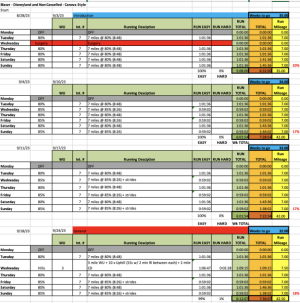
Moving into the week of Sept 25th, we start moving into some real workouts. The hill sprint workout will continue for the next 3 weeks. In addition, I'll do some other classic Canova workouts:
LR/HMT Alternations: 2 mile WU + 20 sets of (1 min @ 8:48 + 1 min @ 7:02)
LR at 80% on Jack/Jill route: 10 miles @ 8:48 min/mile (Jack/Jill)
Once the LR gets longer, then I'll drop back down the mileage of the long run and increase the pace to 85% (8:02).
I'll be aiming for three hard workouts per week on Tues/Thurs/Sun.
At the end of this 4 week block is the Disney World trip for the Halloween party. So I'll keep running, but at a reduced volume.
Running volume wise the plan hovers around 48 miles per week in roughly 7 hours.
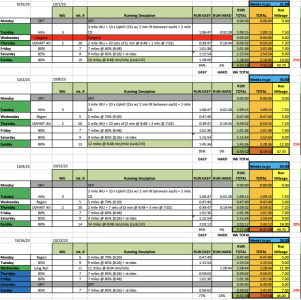
Once we return home from Disney, it's time to get down to business by entering the Canova Fundamental phase.
I'll continue to aim for hard workouts on Tues/Thurs/Sun. Workout wise, we're looking at:
Long Alternations: 1.5 mile WU + 4 x 1 miles @ HM Tempo UPHILL w/ 1 mile @ 8:48 between + 1.5 mile CD
These uphill workouts will be on the Jack/Jill hill running relatively fast up the hill and then taking it easier down the hill for the same mile.
Short Alternations: 1.5 mile WU + 10 x 3 min at 109% with 2 min RI + 1.5 mile CD
One thing that I felt was missing from the last Canova plan was more really faster paced work. So this one touches on that range.
The Madison HM comes on 11/12/23. This is tentatively scheduled, and we'll see how I'm feeling fitness wise as to whether I'll go through with it.
Progression Alternations: 1.5 mile WU + 4 x 1 miles @ 7:05, 7:00, 6:55, 6:50 UPHILL w/ 1 mile @ 8:48 between + 1.5 mile CD
Advancing the long alternations from HM Tempo to pushing the pace a bit harder on each.
Wrap up the 4 week block with the longest training run so far at 18 miles at a very leisurely 8:48 (80%) pace.
Running volume wise the plan hovers around 54 miles per week in roughly 8 hours.
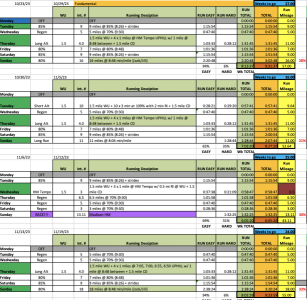
Two final weeks of Fundamental before moving into the Specific phase.
Workout wise we're looking at:
Short Alternations: 1.5 mile + 5 x 6 min at 107% (6:50) with 3 min RI + 1.5 mile
Slower, but longer.
Last Call HM is more likely to happen given it's a little further into the future. Additionally, there's still six weeks before the Disneyland weekend. So plenty of time to recover and attack the remaining training in the specific phase.
Uphill Ladder: 1.5 mile WU + Uphill Ladder (3min 6:44, 6min 6:54, 9 min 7:02, 12min 7:20, 9min 7:02, 6min 6:54, 3min 6:44) with 2.5min RI between + 1.5 mile CD
This will be a progressive climb up the hill and then back down, and then write back up again. We'll see how it goes, but this one looks fun.
Mona: 1 mile WU + 3 sets of (1 mile HM Tempo Uphill + 2 min RI + 4 x 15s w/ 2 min RI) + 1 mile CD
Mix of HM Tempo and then some quick sprints.
Specific Intensive Endurance: 2 mile WU + 4 sets of (1km at 6:50 + 1km at 7:20) + 2 mile CD
An over/under workout around HM Tempo pace.
Doubles start up again, but not with two hard workouts quite yet (as was seen in the last Canova training plan). I really liked how the doubles felt last year, and I'm testing out a new routine that I plan to use in the second training plan. The morning workout is a super easy paced treadmill workout, and then the evening workout is a slightly quicker easy pace.
Now that the series of races has started, the running volume hovers around 52 miles per week in roughly 7-7.5 hours.
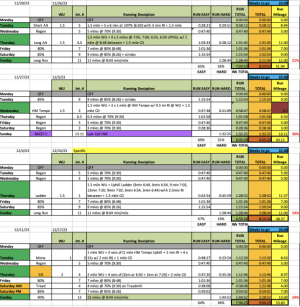
As we enter the end of the first training plan, the running volume hovers around 54 miles per week in roughly 7.5-8 hours.
We see more similar workouts with the Ladder, Long Alternations, the first time we see a 90% paced LR, Mona, SIE, a double, and then Disneyland race weekend.
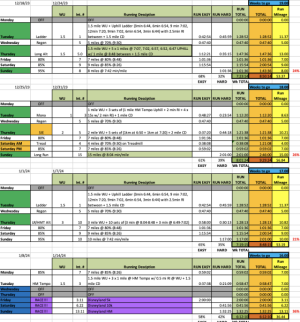
Coming up,
part 2!
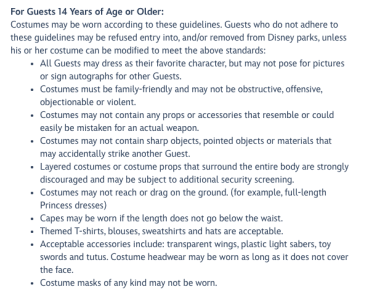






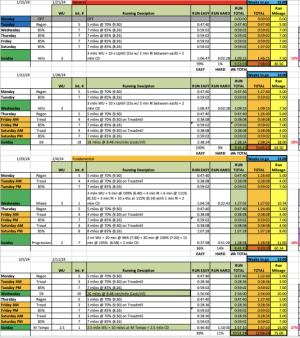
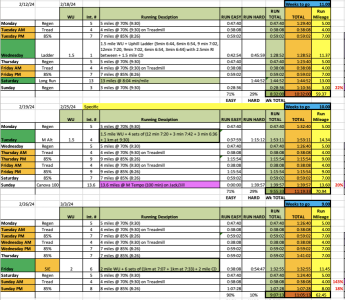
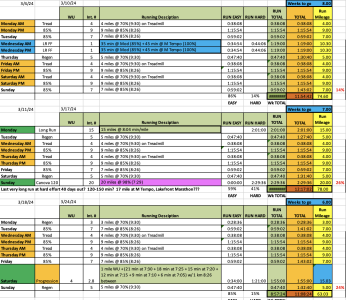

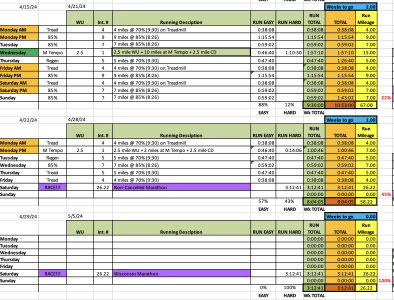
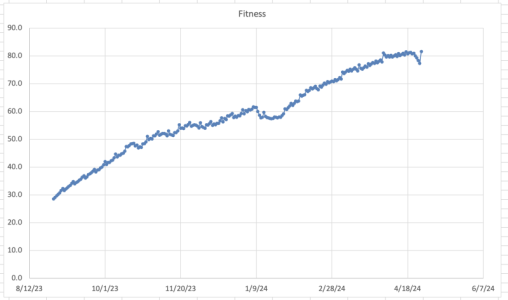
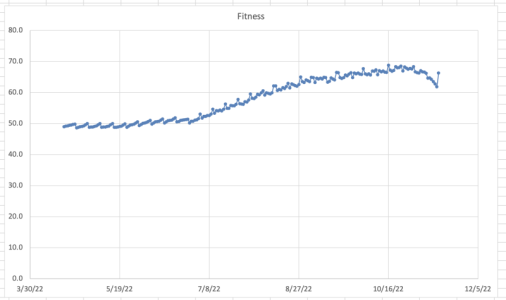
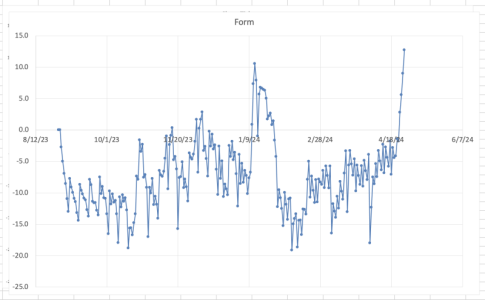
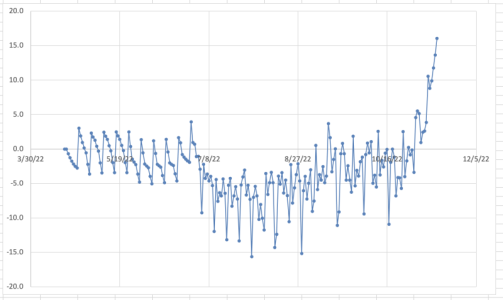
 I was consistent with the training, and because of the 2 day gap, was able to really go after the speed/strength and tempo efforts, and stayed healthy throughout. And I'm no spring chicken anymore.
I was consistent with the training, and because of the 2 day gap, was able to really go after the speed/strength and tempo efforts, and stayed healthy throughout. And I'm no spring chicken anymore.